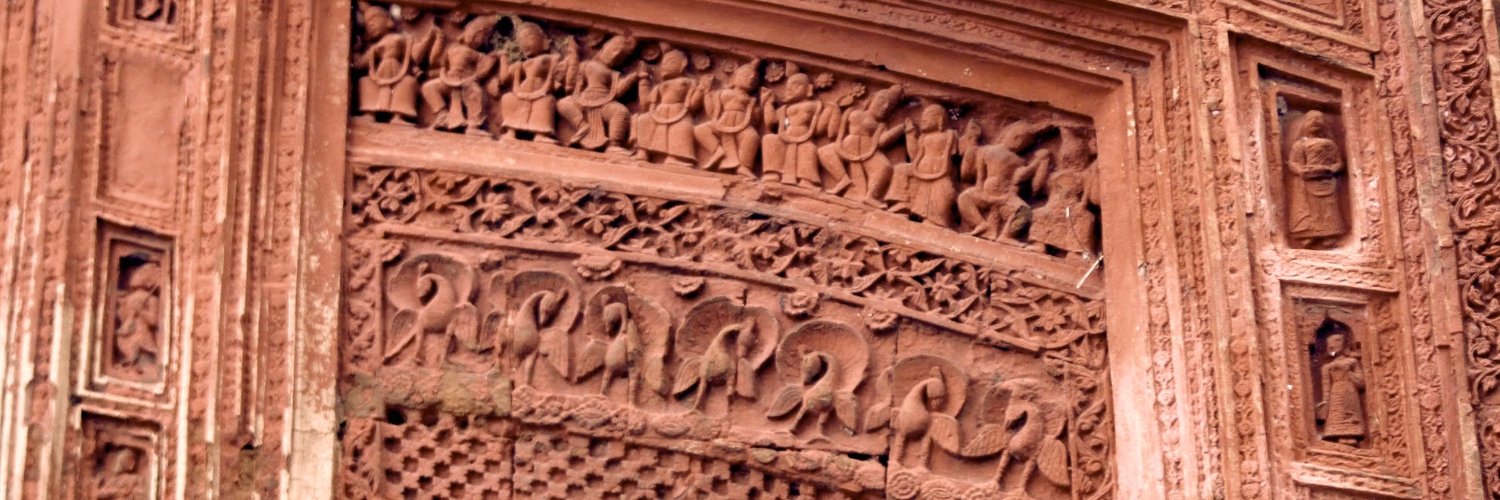
Amit Guha
@AmitGuha2020
Architecture of Bengal, South Asian Art-History, http://amitguha.bsky.social
For 45 years, Deaf and mute Kashmiri artisan Yusuf Muran has kept the tradition of walnut wood carving alive
Came across this fascinating Basohli painting of Siva as Panchanan on Nandi in front of a mountain (?) on which Kali stands on a sava. Does anyone know if this painting is currently in a museum anywhere? A reverse Google image search does not return much information.

Āyāgapaṭa depicting a Jina surrounded by auspicious symbols, 1st century CE, Mathura, Uttar Pradesh, National Museum, New Delhi. On display in the British Museum’s Ancient India exhibition.
Brahma and Sarasvati seated upon their vahana the hamsa. Early 19th century
Yes. Writing is not a second thing that happens after thinking. The act of writing is an act of thinking. Writing *is* thinking. Students, academics, and anyone else who outsources their writing to LLMs will find their screens full of words and their minds emptied of thought.
"পশ্চিমবঙ্গে একমাত্র বৃহদায়তন 'চারচালা' মন্দিরটি রাজা কৃষ্ণচন্দ্র কর্তৃক নদিয়া জেলার শিবনিবাসে নির্মিত মন্দির সমূহের অন্তর্ভুক্ত 'রাজেশ্বরশিব' (রাজ্ঞীশ্বর), ১৭৬২ খ্রিস্টাব্দের তৈরি, প্রায় ৭০ ফুট উঁচু, ভিতের তুলনায় দেওয়ালের প্রায় দ্বিগুণ।" - ডেভিড ম্যাকাচ্চন
11th century Black Stone Sculpture of Mahiṣāsura Mardinī From Imperial Pala Period
Doorjamb with Śivagaṇas, c. 550 CE, northern India, British Museum. On display in the ongoing Ancient India exhibition.
Rani ki Vav contains over 800 sculptures across seven levels each narrating old legends, stories, cosmic rhythms, and sacred femininity. From Mahishasura Mardini to Dashavatara, every carving is both protector and storyteller.
In this Urdu poem Nazeer Akbarabadi also describes people expertly swimming past Agra's Taj Mahal, which is referred to by its old, local name 'Rauza'. On the right is an illustration of a lush Taj Mahal with admiring visitors, from an 18th-cent. copy of Amal-i Salih.
In these Urdu verses, Nazeer Akbarabadi celebrates the many joys of swimming in late-18th-century Agra's Yamuna river in Monsoon! Some verses were included in the famous play 'Agra Bazar', listen to them here: Part 1 open.spotify.com/episode/0BAJ2A… Part 2 : open.spotify.com/episode/3dcQOT…
When your gap year could look like so: When Abdul Karim (2nd from left)came to Delhi to study in the 1810s, he may not have bargained to be in the company of this deadly looking bunch of Afghans, also visiting Delhi at the time Delhi, 1816-20, Paul F Walter collection
At the beginning of Shyam Benegal's Arohan, Om Puri briefly steps through the fourth (or perhaps fifth) wall to introduce the film’s politics, cast, and crew, including a candid moment featuring Pankaj Kapoor.
Ravana abducts Sita A scene from the Krittibas Ramayana Calendar Art, Gouache on board Kartik Das, 1980s Ravana moves forward to grasp Sita's hand as she steps out of the Lakshman-rekha to offer food to Ravana disguised as a mendicant. His pushpak chariot waits in the distance.

Wandering through the lanes of #Mathura over the weekend, came across this Kashmiri dharamshala close to the #Yamuna. The exterior is stunning and one carved icon expresses deep loyalty to #British royalty. It is private property and was closed at the time of the visit.
Rama, Lakshmana and Hanuman Textile Label Walter A Clark & Co, Glasgow Late 19th century It was common for British textile manufacturers to use religious iconography borrowed from Indian miniature and folk painting to attract customers.

Stupa Plaque Amaravati, Andhra Pradesh 1st BCE to 8th CE Currently @MuseeGuimet The presence of Siddhartha on his horse, Kanthaka, is suggested by chhatri and chauri bearers and worshippers. Ganas hold Kanthaka’s hooves so as to muffle the noise and hide Siddhartha’s flight.

